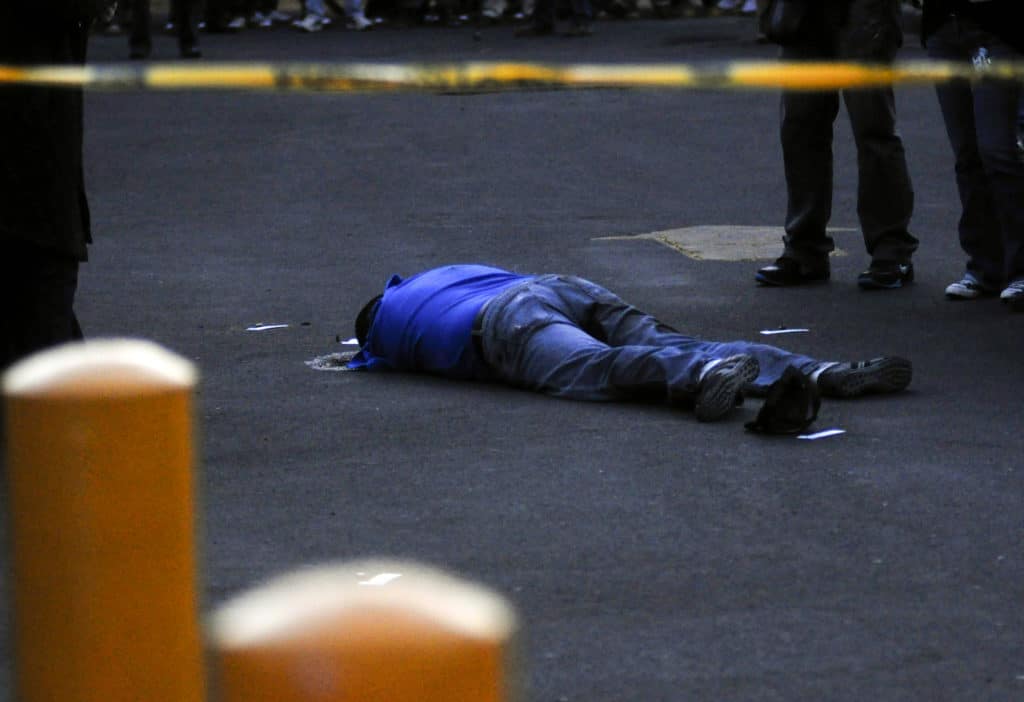Mexico Second to Syria for Deadly Conflict
Mexico News Daily, May 10, 2017

Guadalajara, Mexico – A man executed at a McDonalds’ parking lot in the Mall of Plaza del Sol. (Credit Image: © Rafael Del Rio/DPA/ZUMAPRESS.com)
Mexico recorded 23,000 homicides attributed to the ongoing drug war in 2016, making it the world’s second deadliest conflict zone only behind Syria, according to the annual Armed Conflict Survey released yesterday by the International Institute for Strategic Studies (IISS).
John Chipman, chief executive and director-general of the IISS said, “This is all the more surprising, considering that the conflict deaths [in Mexico] are nearly all attributable to small arms.”
High rates of homicide were also recorded in the “Northern Triangle” (Guatemala, Honduras and El Salvador) of Central America, but while those countries recorded modest improvements in 2016, Mexico did not.
Although the other countries that make up the top four — Syria (50,000 deaths in 2016), Iraq (17,000) and Afghanistan (16,000) — have received prominent coverage by international news media, Mexico has attracted much less attention.
One analyst, assistant head of the U.S. and Americas program at London Think Tank Chatham House, attributes the less than prominent coverage of Mexico to the fact that the combatants in the conflict — drug cartels — are not fighting for an overtly political purpose.
“It’s not a war in the political sense of the word,” said Jacob Parakilas. “The participants largely don’t have a political objective. They’re not trying to create a breakaway state. It doesn’t come with the same visuals. There are no air strikes.”
Drug violence in Mexico is largely caused by territorial disputes between opposing cartels fighting to control lucrative smuggling routes into the United States.
However, power struggles within cartels, such as the split in the Sinaloa Cartel after the arrest of head honcho Joaquín “El Chapo” Gúzman last year, can also lead to increased violence.
Cartels also wage war against state military forces using their own military-grade weapons, paid for with untold riches — US $19-$29 billion annually according to the U.S. Department of Homeland Security — gained through transnational drug trafficking.
Last year was the most violent since President Enrique Peña Nieto took office in December 2012 with a 22.8% increase in intentional homicides over 2015, and statistics for the first few months of 2017 show that the trend is worsening.
There were 2,020 homicides recorded in March, making it the bloodiest month since June 2011 when the country was in the midst of a militarized cartel-fighting strategy implemented by Peña Nieto’s predecessor, Felipe Calderón.
Antonio Sampaio, research associate for security and development at survey author IISS, argues that the increase in drug-related violence is caused by militarization of cartels, “an arms race of sorts,” coupled with “the institutional weakness and pervasive corruption that have plagued the Mexican state.”
Cartels have become more aggressive in their tactics to intimidate locals, rival cartels and the state, all in the pursuit of one thing — territorial autonomy that gives them the freedom to conduct illicit activities such as cocaine smuggling and production of other illegal substances such as heroin and increasingly methamphetamine.
Los Zetas used aggressive tactics to grow exponentially during the years of Calderón’s war on drugs, Sampaio says, leaving mass casualties while more recently the Jalisco New Generation Cartel has adopted a similarly hawkish strategy and through it has come to rival the Sinaloa Cartel in size and territorial presence.
Peña Nieto has continued to respond to security issues by dispatching federal forces, often the military, despite vowing to take a less militarized approach than his predecessor and has preferred to play down the violence plaguing the country, emphasizing instead reforms that his government has made.
Despite security scandals plaguing his administration, most notably the disappearance of 43 teaching students in Iguala, Guerrero, a decrease in federal security spending was announced in January.
Stagnant growth has been blamed for the country’s inability to dedicate more funds to the much-needed area leading to predictions that 2017 may be the most violent year ever.
A plunge in the value of the peso has also complicated funding for the Mexican government while cartels, whose revenues are mostly in dollars, have benefited.
Today, the Secretariat of Foreign Affairs (SRE) released a statement questioning and challenging the IISS report.
“Their conclusions do not hold up in the case of Mexico” because one of their determining factors is that there is an internal armed conflict. That, the statement said, does not exist, “and just because there are criminal groups isn’t an adequate criterion to speak of an armed conflict.”
The SRE also rejected the argument that the use of the armed forces to maintain security meant that an armed conflict was taking place. It also stated “the total estimate for homicides on a national level has not yet been published by Inegi [the National Statistics Institute] so the origin of the figures used in the report is unknown.”















